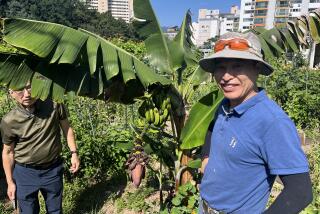Bananas and genetic engineering: Past, present and future
- Share via
Scientists are fighting to protect the hundreds of bananas and plantains people eat around the world from a blizzard of pests: insects, fungi, worms, bacteria and viruses.
They’re using old methods and new ones in their fight, as noted in our news story on the successful sequencing of the banana genome by French scientists.
In Uganda, for example, scientists have been using conventional breeding, crossing fertile wild bananas to local bananas that are eaten. They’re trying to develop resistances to banana blights such as black leaf streak disease, a.k.a. black sigatoka, said Andrew Kiggundu, plant biotechnology research officer at the country’s National Agricultural Research Laboratories Institute in Kawanda. The Black Sigatoka fungus attacks the leaves and can cause production losses of up to 50%.
A hybrid banana resistant to black sigatoka is now being scaled up for distribution for farmers, Kiggundu said.
Uganda is also where the first African field trials for genetically modified bananas took place, starting in 2007. (People in Uganda eat almost a kilo of bananas a day, so it’s a very important food crop.)
The trials were done under carefully controlled field conditions, Kiggundu said, and the bananas showed some limited resistance to black sigatoka in the field, with slower disease progression than regular bananas. But the scientists need the plants to do better. They are going back to the drawing board and rejiggering their technology in the hope that they’ll see improved resistance.
In collaboration with a variety of other researchers around the world, the Uganda team is also working on genetically modified bananas with resistance to nematodes, weevils, bacterial wilt and a mold called Panama disease, as well as higher levels of vitamin A and iron, and delayed ripening.
What is a “resistance gene” anyway? How does a plant ward off pests?
In the case of the black sigatoka field trial, bananas were engineered with rice genes that carry instructions for proteins called chitinases. Chitinases break up molecules called chitin – found in insect skeletons and also the cell walls of fungi.
Bananas genetically modified to fight bacterial wilt make two proteins from sweet pepper. One of them is plant ferrodoxin-like protein. It triggers a strong response when plants are attacked by pathogens. The plant, in this response, essentially kills off its own tissue around the site of the infection. At the same time, lots of highly reactive oxygen species are produced, which can attack the invader. And the plant starts making antimicrobial chemicals.
To name just two examples.
Plants naturally have genetic resistances because they are constantly fighting off pests in the wild. And that includes many wild bananas. Since the genome of one wild banana, a subspecies of Musa acuminata (Pahang), has now been sequenced, researchers hope in the future that some of the genes that they use for engineering resistance and other qualities will come from bananas themselves. Variability exists aplenty in bananas -- it’s just hellish to breed traits into the ones people like to eat because the edible ones are not fertile.
Bananas were once explored for another biotech use: creating edible vaccines against various human diseases. Charles Arntzen, a plant biotechnologist at Arizona State University, had in mind producing bananas engineered to make a protein from the bacterium that causes cholera.
This protein doesn’t cause disease “but it’s a very good vaccine,” Arntzen said. The bananas would be harvested and made into chips and powder and these would be given to people in developing countries who don’t have good access to modern vaccines. The banana chips, once eaten, would expose the body to the cholera protein and offer resistance later on to encounters with the cholera bacterium.
Arntzen once had high hopes for the concept (he worked on something similar in tomatoes), but the regulatory hurdles for an edible vaccine plus the money needed for safety trials made the whole endeavor too complicated, he said. He and most others have abandoned the effort and moved on to growing non-edible vaccines in tobacco plants.
The remaining edible vaccine efforts are mostly for delivery to fish and other animals, Arntzen said.
You can read lots more about bananas at the following websites:
The banana website for the nonprofit group Bioversity International; the International Magazine on Banana and Plantain (if it’s not already on your coffee table); Uganda’s National Banana Research Program; the book “Banana: The Fate of the Fruit that Changed the World.”
And a review at the state of the banana by Pat Heslop-Harrison and Trude Schwarzacher, “Domestication, Genomics and the Future for Banana.”
[For the record, 12:30 p.m. July 13: An earlier version of this post incorrectly said that Charles Arntzen works at Northern Arizona University. Arntzen works at Arizona State University.]






